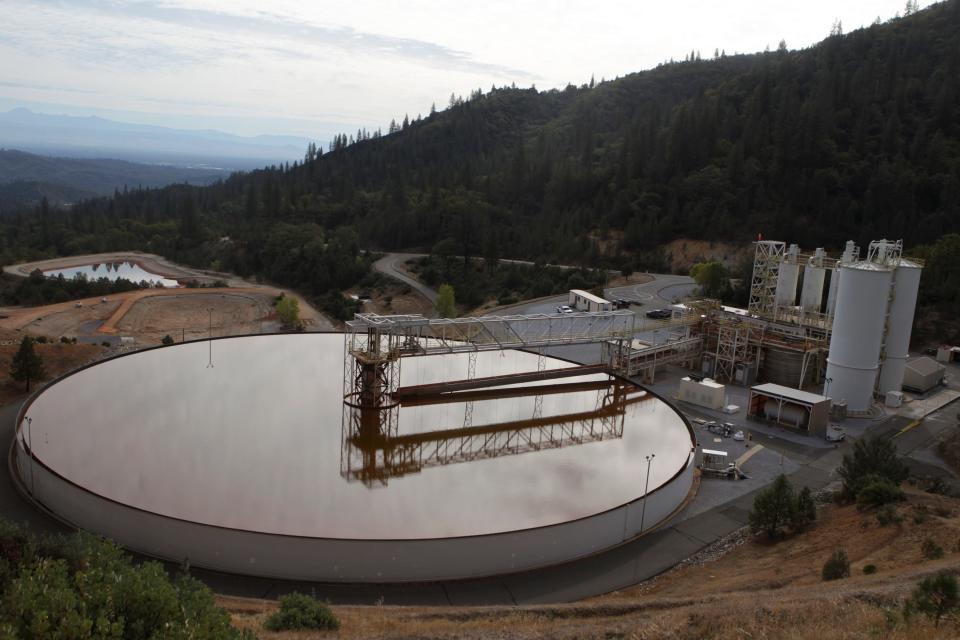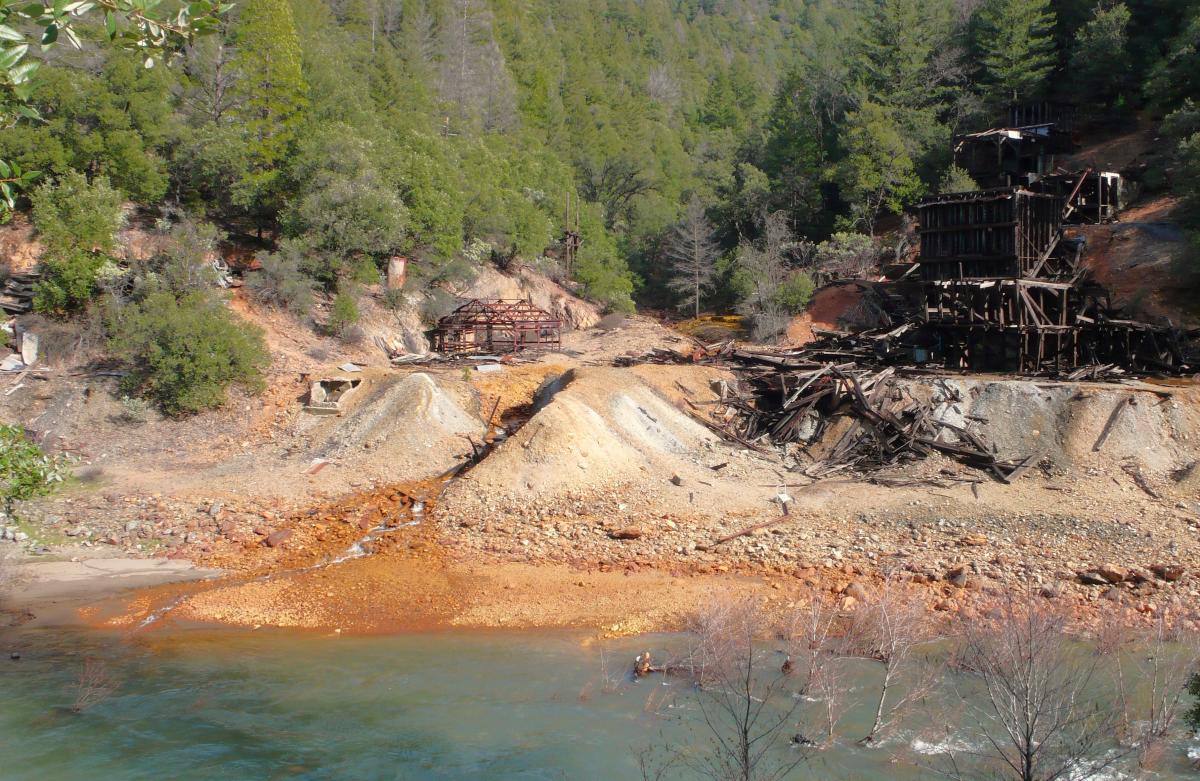An abandoned Shasta County mine that produces toxic pollution at about 1,200 times the allowable standard has been named a U.S. Environmental Protection Agency Superfund cleanup site.
The Afterthought Mine, located about 25 miles east of Redding near Highway 299, was placed on the list Wednesday because of the metals and highly acidic water that flows from the mine and nearby Little Cow Creek, which is a tributary to the Sacramento River, according to the EPA.
When mine workers dug into the hills near the mine, the minerals that were exposed to the air and water became an acid that has continued to flow from the tunnels for decades, said John Hillenbrand, an EPA project manager.
The solution coming from the mine is “pure acid” that’s akin to battery acid, he said.
“So it’s really nasty stuff. And then it leaches out all the metals, and they come out the mine tunnel and dumps them into the river, in this case little Cow Creek right there gets the kind of brunt of it. So this is acid mine drainage, right? And it just comes out every day, 24 hours a day. It varies in amount, 250 gallons a minute or more can come out of this thing and go right into the creek,” Hillenbrand said.
More: Push to protect Sáttítla, Medicine Lake lands, gets huge backing from California lawmakers
In addition to the acid, the water is “pretty much loaded with copper and cadmium, zinc and arsenic,” Hillenbrand said.
“Downstream of the site, the surface water and sediments in Little Cow Creek are contaminated with cadmium, copper, and zinc at levels approximately 100 times, 1,200 times and 1,000 times, respectively, above the California Toxics Rule Water Quality Criteria for acute risk,” according to a description of the mine on the EPA’s website.
Naming the mine a Superfund site puts the area on a path to cleanup, Hillenbrand said. The agency will spend the next three to five years studying the mine and flows from the tunnels to determine the best method for treating the water.
“But here’s one of our goals: We try not to build things that need a lot of pumps and people and electricity because that’s expensive. So, if we can spend a little extra time and make it passive — meaning, like natural bacteria filtering systems — we prefer to do that,” Hillenbrand said.
The treatment will go on for possibly hundreds of years, he said, “because this site will never stop generating water, ever. It’ll just go on in perpetuity, for thousands of years. So we want to try to get it right.”
In addition to treating the water, the contaminated rocks at the site will need to be hauled away and covered up so they are no longer a threat to the environment, he said.
In Little Cow Creek, the water remains harmful to fish and humans should not drink it or come in contact within the immediate area, Hillenbrand said. The water is diluted by the creek downstream and does not pose a problem to humans. People should not cross the creek from Highway 299 to where the water flows from the mine, he said.
Note to readers: We’ve made this story free as an important public service. If you are able, help power local journalism. Subscribe to the Redding Record Searchlight.
“The bank closest to the mine, probably the 10% or 15% of it along the edge there, is orange right as the water’s mixing acid in with the river. So if I was a fish, I wouldn’t want to swim over there. I’d swim on the opposite side of the creek,” Hillenbrand said.
The current property owners did not develop the mine so they do not have to pay for the cleanup, he said. Taxpayers will foot the bill for the cleanup, he said. Hillenbrand did not have an estimate of the cost to treat the water.
The Afterthought Mine becomes the second Superfund site in the county. The Iron Mountain Mine, which sits on 4,400 acres northwest of Redding, has been on the EPA’s list since 1983.

Hillenbrand said the facilities used to treat the water at Iron Mountain are more elaborate and intensive than will likely be necessary for the Afterthought Mine.
The EPA’s website pages on Iron Mountain Mine says that “Before cleanup, the acidic metal-rich water virtually eliminated aquatic life in local creeks and caused periodic fish kills in the Sacramento River.”
Hillenbrand said Iron Mountain mine’s pollution levels are much worse than the Afterthought Mine.
“There is nothing worse than Iron Mountain Mine in the entire country. Iron Mountain Mine is like a 1,000 times bigger than this mine. It (the water in the mine) has a negative pH, so it has a pH of like minus 2 or 3. It’s unbelievable how bad it is,” he said, describing the mine water’s acidity.
The pH of most drinking water lies within the range of 6.5 to 8.5, the World Health Organization says.1
The Afterthought Mine was first developed in 1862 and continued to operate until 1952. Remnants of the mine, including wooden structures, can still be seen from Highway 299 in the tiny community of Ingot, east of Redding.
‘Monstrous:’ Grandfathers describe pain of losing 2-year-old murdered by her mother
The EPA said 166,424 tons of ore, 10,730,580 pounds of copper, 23,635,840 pounds of zinc, 1,738,300 pounds of lead, 923,653 ounces of silver and 4,992 ounces of gold were taken from the mine.
The remnants of an inactive smelter associated with the mine, called the Afterthought Smelter, is located about a mile downstream from the mine site, the EPA said.
Shasta County Supervisor Mary Rickert, whose district includes the mine, said she had heard about the proposed cleanup and said she was happy it was named a Superfund site.
She said Little Cow Creek, which receives the toxic mine drainage, “drops into Cow Creek and then it goes through a lot of residential, properties, and it impacts a lot of people, and your cattle are drinking out of the creeks. So I think it’s something that is probably long overdue.”
Reporter Damon Arthur welcomes story tips at 530-338-8834, by email at damon.arthur@redding.com and on X, formerly known as Twitter, at @damonarthur_RS. Help local journalism thrive by subscribing today!
This article originally appeared on Redding Record Searchlight: Shasta County mine with ‘pure acid’ water now an EPA Superfund site
